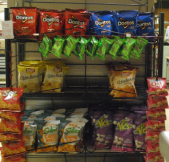Regulations affect lunches and fundraisers

At the beginning of the 2014-2015 school year, the Smart Snacks in School Nutrition Standards were put into effect to improve the nutritional value of food consumed during the school day. As a result, food from the school a la cartes, vending machines and fundraising events must meet these standards.
According to the Alliance for a Healthier Generation, there can’t be more than 35 percent of calories in total fat, 10 percent of calories in saturated fat or 35 percent of sugar “by weight” and there can’t be any trans fat. Entrées can’t exceed 350 calories or 480 milligrams of sodium while snacks cannot exceed 200 calories or 230 milligrams of sodium.
Because of the sodium and fat limits, FHS’s salad dressings and products from manufacturers, such as Frito Lay, had to change.
“Manufacturers had to adjust their formulas,” Food Service Director Mrs. Dawn Fronius said. “They knew this was going to happen, but I think they thought that there was going to be a little pull-back and, consequently, at the beginning of the school year, we had a hard time getting product.”
In addition, foods must be “whole grain rich,” have a fruit or vegetable component, a primary fruit, vegetable, protein or milk ingredient or, until July 1, 2016, at least 10 percent of certain nutrients.
Drinks are also regulated under these standards. Drinks like water, 100 percent juice and low fat or fat free milk are allowed. At the high school carbonated, low calorie, diet and caffeinated drinks are permitted, but low calorie and diet drinks have a calorie limit.
“The USDA supersedes everything. We can’t be less restrictive than the USDA, but we can be more restrictive,” Fronius said.
These regulations don’t apply to the food and drinks served at after school events or food brought in for classroom parties.
The new nutritional requirements have also limited student fundraisers. If the fundraiser is selling food that could be consumed during the school day, it must meet the nutritional requirements or be sold after school hours. This means that food that doesn’t meet these requirements, like candy bars, cannot be sold as a school fundraiser during the school day.
“The school day is defined [as] midnight to 30 minutes after the last bell,” Fronius said.
Each state has the power to allow a certain number of fundraisers to be exempt from the regulations, so they can be sold during the school day. In Pennsylvania, up to 10 exempt fundraisers are allowed in the high school. A club or organization can only have one approved exempted fundraiser, which can’t last longer than a week, per school year.
“Ten groups can apply for an exemption, but once they apply, they have to give me [and the principal] all the information,” Fronius said. “We have to know what, when [and] where [and] we have to see labels.” All groups requesting an exemption must apply at least one month before the fundraiser.
Every five years, the dietary guidelines are updated. The most recent update to these guidelines was the Healthy, Hunger-Free Kids Act of 2010. Most of these new nutritional standards set on school breakfast and lunch were put in place in the 2012-2013 school year. One of the effects was that high school students were required to take at least a cup of both fruits and vegetables in order for the meal to be considered complete.
If a student doesn’t order a complete meal, they will be charged at the a la carte rate.
Food and drinks that are sold with school meals already meet these nutritional requirements, so they aren’t affected by the Smart Snacks in School Nutrition Standards.
“We have to prove to the USDA through a program that we have, a product and meal calculator, that our schools meet the standards set upon us,” Fronius said.
The Healthy, Hunger-Free Kids Act guidelines will expire in September 2015, so an update to these guidelines will take effect in the future.


